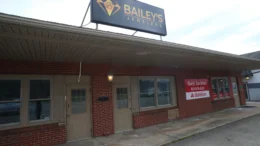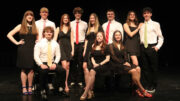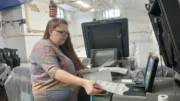NEW YORK (AP) — The eight people killed in a truck driver’s rampage were honored by friends and strangers Thursday with a nighttime walk down the riverfront esplanade where the victims died as both investigators and terror-weary New Yorkers tried to make sense of the crime.
Some of the marchers carried candles as city lights twinkled on the water. Others pushed bicycles in solidary with the victims, who were cut down on the long bike path that runs the length of Manhattan’s Hudson River waterfront.
The mourners included Harry Kassen, a student at the Manhattan school where one of the victims, Nicholas Cleves, 23, worked part-time.
“You never think it is going to be someone you know,” said Kassen, 17. He said he’d just recently worked with Cleves on lighting and sound for a school performance.
“We were up in the tech booth, chatting. Then, two weeks later, here we are. And he’s gone,” Kassen said.
The march began near the spot where authorities say Sayfullo Saipov, 29, an immigrant from Uzbekistan, steered a rented truck onto a bike bath and sped south toward the World Trade Center, striking cyclists and pedestrians in his bath. He was shot by a police officer after crashing the truck into a school bus and arraigned Wednesday on terrorism charges.
Two women carried the flag of Argentina, in remembrance of the five people from that country who were killed when Saipov’s truck plowed into a group of friends who had come to New York together to celebrate the 30th anniversary of their high school graduation.
The memorial walk and vigil took place hours after several of the Argentinian survivors of the attack visited a severely injured and hospitalized member of their group, Martin Marro, of Newton, Massachusetts, to tell him for the first time which of his friends had died.
“I think Martin had to know the truth. Maybe he already imagined that but now he knows and is a step that his friends wanted to take before returning to Argentina,” Argentina’s consul in New York, Mateo Estreme, told reporters in Spanish. “It was something very emotional for all of them.”
New York officials on Thursday began to put up temporary concrete barriers at 57 locations where it is possible for vehicles to turn onto the bike bath where the attack took place.
Long stretches of the path are shielded from traffic by berms planted with trees and shrubs, but vehicles have gotten onto it before. A cyclist was killed at nearly the same spot where some of the victims were struck in 2006 when a drunk driver entered the path by mistake.
For years, the city and private property owners concerned about truck bombs and other attacks have been gradually installing thousands of metal posts to block vehicles from getting onto sidewalks and public plazas. In May, one of those bollards halted a car speeding down a crowded sidewalk in Times Square, but not until it had killed one person and injured more than 20.
The New York Police Department’s top counterterrorism official, John Miller, said investigators still hadn’t uncovered evidence that Saipov had any accomplices in the attack, but said information was still being gathered.
A propaganda arm of the Islamic State group called Saipov “a soldier of the caliphate.” A message in an Islamic State weekly newspaper used the term in an item published late Thursday. That item then was translated by the SITE Intelligence Group. The Islamic State group has an interest in taking credit for attacks carried out by individuals who are self-radicalized.
In their search for clues, FBI investigators have questioned Saipov’s wife and some of his acquaintances, including a fellow immigrant from Uzbekistan, Mukhammadzoir Kadirov, who said he had gotten to know him when they were both Uber drivers.
On Thursday, Kadirov released a statement to The Associated Press through a person in touch with his family condemning the plot.
“It is so sad and unbelievable. This not from our religion. It is not acceptable. We as Muslims completely reject this kind of actions. No human being who has a heart can do this,” the statement said.
Two mosques in Paterson, New Jersey, where Saipov lived, said they have been receiving threats since the attack. The Islamic Center of Passaic County said it has gotten eight telephone threats to burn the center down and kill its occupants, prompting extra police patrols.
President Donald Trump tweeted out messages early Thursday calling for Saipov’s execution.
In a highly unusual instance of a president weighing in on the fate of a defendant awaiting trial, Trump wrote that prosecutors “Should move fast. DEATH PENALTY!”
The comments could give defense attorneys grounds to argue that Trump has poisoned the minds of potential jurors, but some legal experts said they doubted judges in Manhattan’s federal courts would let the president’s remarks derail the case in a courthouse with a quarter-century record of swift terrorism prosecutions with mostly airtight outcomes.
Lawyers differed over whether Trump was out ethically out of bounds.
“Even presidents are entitled to First Amendment rights,” said Michael Wildes, a former federal prosecutor.
Joshua Dratel, a veteran defense attorney in terrorism cases, said the tweets should disqualify prosecutors from seeking the death penalty.
“It’s inconceivable that it would be fair to seek the death penalty when the president has expressed it twice in a tweet,” he said. “It poisons the jurors, all the prospective jurors.”
Meanwhile, Saipov’s court-appointed lawyer, David Patton, said he hopes “everyone lets the judicial process play out.”










































